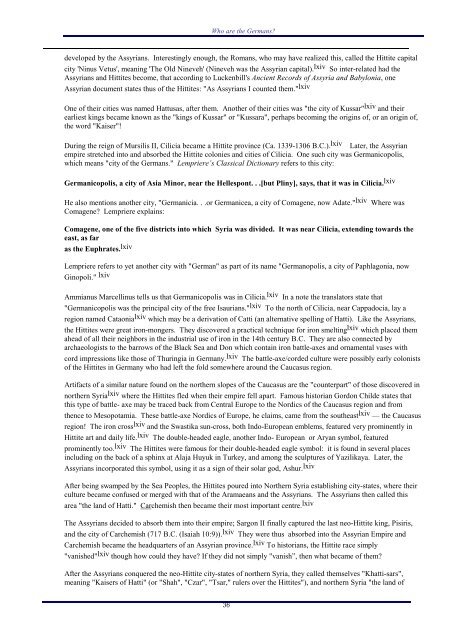WHO ARE THE GERMANS - Churches of God Cyber Auxiliary
WHO ARE THE GERMANS - Churches of God Cyber Auxiliary
WHO ARE THE GERMANS - Churches of God Cyber Auxiliary
Create successful ePaper yourself
Turn your PDF publications into a flip-book with our unique Google optimized e-Paper software.
Who are the Germans?<br />
developed by the Assyrians. Interestingly enough, the Romans, who may have realized this, called the Hittite capital<br />
city 'Ninus Vetus', meaning 'The Old Nineveh' (Nineveh was the Assyrian capital). lxiv So inter-related had the<br />
Assyrians and Hittites become, that according to Luckenbill's Ancient Records <strong>of</strong> Assyria and Babylonia, one<br />
Assyrian document states thus <strong>of</strong> the Hittites: "As Assyrians I counted them." lxiv<br />
One <strong>of</strong> their cities was named Hattusas, after them. Another <strong>of</strong> their cities was "the city <strong>of</strong> Kussar" lxiv and their<br />
earliest kings became known as the "kings <strong>of</strong> Kussar" or "Kussara", perhaps becoming the origins <strong>of</strong>, or an origin <strong>of</strong>,<br />
the word "Kaiser"!<br />
During the reign <strong>of</strong> Mursilis II, Cilicia became a Hittite province (Ca. 1339-1306 B.C.). lxiv Later, the Assyrian<br />
empire stretched into and absorbed the Hittite colonies and cities <strong>of</strong> Cilicia. One such city was Germanicopolis,<br />
which means "city <strong>of</strong> the Germans." Lempriere’s Classical Dictionary refers to this city:<br />
Germanicopolis, a city <strong>of</strong> Asia Minor, near the Hellespont. . .[but Pliny], says, that it was in Cilicia. lxiv<br />
He also mentions another city, "Germanicia. . .or Germanicea, a city <strong>of</strong> Comagene, now Adate." lxiv Where was<br />
Comagene? Lempriere explains:<br />
Comagene, one <strong>of</strong> the five districts into which Syria was divided. It was near Cilicia, extending towards the<br />
east, as far<br />
as the Euphrates. lxiv<br />
Lempriere refers to yet another city with "German" as part <strong>of</strong> its name "Germanopolis, a city <strong>of</strong> Paphlagonia, now<br />
Ginopoli." lxiv<br />
Ammianus Marcellinus tells us that Germanicopolis was in Cilicia. lxiv In a note the translators state that<br />
"Germanicopolis was the principal city <strong>of</strong> the free Isaurians." lxiv To the north <strong>of</strong> Cilicia, near Cappadocia, lay a<br />
region named Cataonialxiv which may be a derivation <strong>of</strong> Catti (an alternative spelling <strong>of</strong> Hatti). Like the Assyrians,<br />
the Hittites were great iron-mongers. They discovered a practical technique for iron smeltinglxiv which placed them<br />
ahead <strong>of</strong> all their neighbors in the industrial use <strong>of</strong> iron in the 14th century B.C. They are also connected by<br />
archaeologists to the barrows <strong>of</strong> the Black Sea and Don which contain iron battle-axes and ornamental vases with<br />
cord impressions like those <strong>of</strong> Thuringia in Germany. lxiv The battle-axe/corded culture were possibly early colonists<br />
<strong>of</strong> the Hittites in Germany who had left the fold somewhere around the Caucasus region.<br />
Artifacts <strong>of</strong> a similar nature found on the northern slopes <strong>of</strong> the Caucasus are the "counterpart" <strong>of</strong> those discovered in<br />
northern Syrialxiv where the Hittites fled when their empire fell apart. Famous historian Gordon Childe states that<br />
this type <strong>of</strong> battle- axe may be traced back from Central Europe to the Nordics <strong>of</strong> the Caucasus region and from<br />
thence to Mesopotamia. These battle-axe Nordics <strong>of</strong> Europe, he claims, came from the southeastlxiv — the Caucasus<br />
region! The iron crosslxiv and the Swastika sun-cross, both Indo-European emblems, featured very prominently in<br />
Hittite art and daily life. lxiv The double-headed eagle, another Indo- European or Aryan symbol, featured<br />
prominently too. lxiv The Hittites were famous for their double-headed eagle symbol: it is found in several places<br />
including on the back <strong>of</strong> a sphinx at Alaja Huyuk in Turkey, and among the sculptures <strong>of</strong> Yazilikaya. Later, the<br />
Assyrians incorporated this symbol, using it as a sign <strong>of</strong> their solar god, Ashur. lxiv<br />
After being swamped by the Sea Peoples, the Hittites poured into Northern Syria establishing city-states, where their<br />
culture became confused or merged with that <strong>of</strong> the Aramaeans and the Assyrians. The Assyrians then called this<br />
area "the land <strong>of</strong> Hatti." Carchemish then became their most important centre. lxiv<br />
The Assyrians decided to absorb them into their empire; Sargon II finally captured the last neo-Hittite king, Pisiris,<br />
and the city <strong>of</strong> Carchemish (717 B.C. (Isaiah 10:9)). lxiv They were thus absorbed into the Assyrian Empire and<br />
Carchemish became the headquarters <strong>of</strong> an Assyrian province. lxiv To historians, the Hittite race simply<br />
"vanished" lxiv though how could they have? If they did not simply "vanish”, then what became <strong>of</strong> them?<br />
After the Assyrians conquered the neo-Hittite city-states <strong>of</strong> northern Syria, they called themselves "Khatti-sars",<br />
meaning "Kaisers <strong>of</strong> Hatti" (or "Shah", "Czar", "Tsar," rulers over the Hittites"), and northern Syria "the land <strong>of</strong><br />
36


